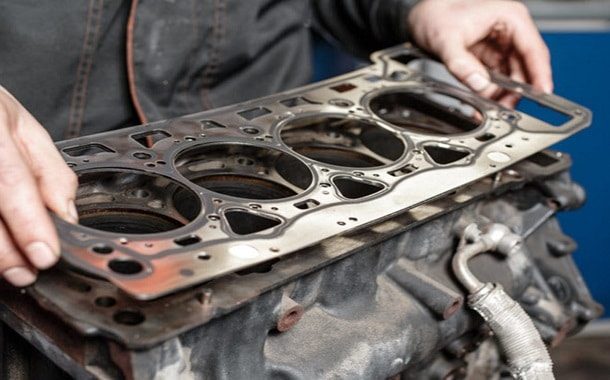How Much Does Head Gasket Repair Cost?
Last Updated on March 5, 2024
Written by CPA Alec Pow | Content Reviewed by ![]() CFA Alexander Popinker
CFA Alexander Popinker
The head gasket is a critical component in your engine, sealing the cylinder head against the engine block and ensuring proper combustion and cooling. When this gasket fails, it can lead to a cascade of issues, including coolant leaks, compression loss, and even engine overheating.
Addressing a faulty head gasket promptly is crucial to avoid further damage and costly repairs. This comprehensive guide will delve into the factors influencing head gasket repair costs, empowering you to make informed decisions about your vehicle’s maintenance.
Highlights
- Professional repairs typically range from $850 to $2,850 or more, including labor, parts, and potential machining costs.
- Head gasket repair costs can vary widely depending on factors like vehicle make, model, and severity of damage.
- DIY repairs can be cost-effective but require mechanical expertise and the right tools.
- Choose a reputable mechanic or repair shop with experience in head gasket repairs.
- Consider additional repairs, warranties, and insurance implications when budgeting for head gasket repairs.
- Regular maintenance and preventive measures can help avoid future head gasket failures and costly repairs.
How Much Does Head Gasket Repair Cost?
The total cost of a professional head gasket repair can range from $850 to $2,850 or more, depending on the specific circumstances.
According to DamagedCars, the cost to replace a blown head gasket ranges from $1,500 to upwards of $3,000 as a national average. The cost for head gasket parts themselves varies between $350 and $800, with most head gasket repairs ranging from $1,500 to over $3,000 depending on the car’s year, make, and model.
Junk Car Medics mentions that repairing an engine with a head gasket problem can cost between $1,000 and $2,000 for the whole repair, depending on the engine type and overall condition. The repair process involves disassembling the motor almost completely and replacing the faulty part.
In a Reddit discussion on r/MINI, users share experiences estimating the cost of replacing a blown head gasket, with figures ranging from $2,500 to $3,000.
To give you a better idea of the potential expenses, here’s a breakdown of the costs associated with a professional head gasket repair:
- Head gasket kit: $100 to $300
- Labor: $500 to $1,500
- Coolant flush and refill: $50 to $150
- Machining costs (if required): $100 to $500
- Additional seals and gaskets: $50 to $200
- Miscellaneous fees (shop supplies, disposal fees, etc.): $50 to $200
DIY vs. Professional Head Gasket Repair
One of the most significant factors influencing the cost of head gasket repair is whether you choose to tackle the job yourself or enlist the services of a professional mechanic.
DIY Repair Costs
For those with mechanical experience and the right tools, a DIY head gasket repair can be a cost-effective option. The main expenses will be the head gasket kit (typically ranging from $50 to $300, depending on the vehicle), sealant or gasket material (around $20 to $100), and any specialized tools you may need to purchase or rent.
However, it’s important to note that a DIY repair can be time-consuming and challenging, especially if you need to disassemble and reassemble the engine. Additionally, any mistakes made during the repair process could lead to further damage and higher costs down the line.
Professional Repair Costs
Opting for a professional head gasket repair service can provide peace of mind and a higher likelihood of a successful repair, but it comes at a higher price tag. The costs typically include:
- Labor charges: Depending on the complexity of the job and the mechanic’s hourly rate, labor costs can range from $500 to $1,500 or more.
- Parts and materials: In addition to the head gasket itself, other components like seals, gaskets, and coolant may need to be replaced, adding $100 to $500 to the total cost.
- Machining costs: If the cylinder head or engine block requires resurfacing or machining, this can add an additional $100 to $500 to the bill.
It’s essential to obtain multiple quotes from reputable repair shops and compare prices to ensure you’re getting a fair deal.
Factors Influencing the Cost of Repair
The cost of repairing a head gasket can vary significantly depending on several factors. The vehicle make and model, the severity of the damage, and the repair approach (DIY or professional) all play a significant role in determining the overall expense.
For instance, luxury or high-performance vehicles with more complex engines may require specialized tools and expertise, driving up the labor costs. Additionally, if the head gasket failure has caused extensive damage to other components, such as the cylinder head or engine block, the repair costs will be substantially higher.
Symptoms and Diagnosis of Head Gasket Failure
Identifying a faulty head gasket early is very important to minimize repair costs and prevent further damage. Some common symptoms to watch out for include coolant leaks, white smoke from the exhaust, engine overheating, and oil contamination.
To accurately diagnose the issue, mechanics often perform specialized tests, such as a compression test, leak-down test, or cylinder leakage test. These diagnostic procedures can help pinpoint the source of the problem and provide a more accurate estimate of the repair costs.
Choosing a Repair Provider
If you decide to go the professional route, selecting a reputable and experienced mechanic or repair shop is crucial. Here are some tips to help you make an informed choice:
- Ask for recommendations: Seek advice from friends, family, or online forums for trusted mechanics or shops in your area.
- Check credentials and experience: Look for mechanics or shops that specialize in engine repairs and have experience working on your vehicle’s make and model.
- Request quotes: Obtain detailed written quotes from multiple providers to compare prices and services.
- Inquire about warranties: Reputable mechanics and shops should offer warranties on their work, providing added peace of mind.
You might also like our articles about the cost of fixing the rocker arm, radiator fan, or intake manifold gasket.
Additional Considerations and Repairs
In some cases, a head gasket repair may be accompanied by additional necessary repairs or replacements. These can include:
- Radiator repair or replacement: If the coolant leak is severe, the radiator may need to be repaired or replaced, adding $300 to $1,000 to the total cost.
- Thermostat replacement: A faulty thermostat can contribute to overheating issues, and replacing it may cost $100 to $300.
- Engine flush: To remove any debris or contamination from the cooling system, an engine flush may be recommended, costing around $100 to $300.
Additionally, it’s essential to consider the potential implications of a head gasket repair on your vehicle’s warranty or insurance coverage. Some repair shops may offer extended warranties on their work, while insurance providers may cover a portion of the repair costs in certain situations.
Preventive Measures and Maintenance
 While head gasket failures can occur due to various factors, including age, wear and tear, or manufacturing defects, there are preventive measures you can take to minimize the risk:
While head gasket failures can occur due to various factors, including age, wear and tear, or manufacturing defects, there are preventive measures you can take to minimize the risk:
- Regular maintenance: Follow your vehicle’s recommended maintenance schedule, including regular coolant flushes and inspections.
- Avoid overheating: Monitor your engine temperature and address any overheating issues promptly.
- Inspect for leaks: Regularly check for any coolant or oil leaks and have them repaired immediately.
- Use quality parts and fluids: When replacing components or fluids, choose high-quality, manufacturer-recommended parts and fluids.
Taking these preventive steps can help extend the lifespan of your head gasket and potentially avoid costly repairs down the line.
Final Words
In conclusion, addressing a faulty head gasket is essential to maintaining the health and longevity of your engine.
While the repair costs can be substantial, taking the time to understand the factors influencing the expenses, choosing a reputable repair provider, and exploring preventive measures can help you make informed decisions and potentially save money in the long run.
Frequently Asked Questions
Can I drive with a bad head gasket?
It is generally not recommended to drive with a faulty head gasket, as it can lead to further damage and potentially catastrophic engine failure. A blown head gasket can cause coolant and oil to mix, which can quickly lead to overheating and potential seizure of the engine.
Additionally, compression loss due to a faulty head gasket can significantly reduce engine performance and fuel efficiency. If you suspect a head gasket issue, it’s best to have your vehicle inspected and repaired as soon as possible to avoid more costly damages.
Is a head gasket a big job?
Yes, repairing or replacing a head gasket is considered a significant job, as it typically requires the complete disassembly of the engine’s cylinder head and potentially other components.
This can be a time-consuming and labor-intensive process, especially for more complex or tightly packed engines. Additionally, the cylinder head and engine block may need to be resurfaced or machined to ensure a proper seal with the new gasket.
Due to the intricate nature of the work, head gasket repairs are often best left to experienced professional mechanics or those with advanced mechanical skills.
Is it better to fix a blown head gasket or replace the engine?
The decision to fix a blown head gasket or replace the engine entirely depends on several factors, including the age and overall condition of the engine, as well as the estimated repair costs.
If the engine is relatively new or in good condition, and the repair costs are reasonable compared to the value of the vehicle, fixing the blown head gasket is often the more cost-effective option.
However, if the engine has high mileage or has sustained significant internal damage due to the head gasket failure, replacing the entire engine may be a more practical and long-term solution.
Ultimately, it’s crucial to consult with a trusted mechanic who can thoroughly inspect the engine and provide an estimate for both repair and replacement options.
They can help you weigh the pros and cons of each approach, taking into account factors like the vehicle’s age, mileage, and overall condition, as well as the projected repair costs and potential long-term reliability of the repaired engine.


Leave a Reply
Want to join the discussion?Feel free to contribute!